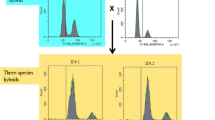Summary
A single tetrad in which one genetical marker had segregated irregularly was analyzed genetically by outcrossing each culture derived from the tetrad to other haploid clones. Regular segregation in the resultant hybrids indicated that the cultures were all haploid. The original ascus was tetratype proving that all four nuclei had survived after reduction. All clones were haploid proving that the irregularities could not have arisen from fusion following an extra mitosis. It is inferred that the extra recessive was the result of an interaction in the hybrid in which a dominant was converted into a recessive allele. The converted clone was identified by the intermediate character of its physiological activity.
Similar content being viewed by others
References
Andrews, J., andR. B. Gilliland, Super-Atternuation of Beer: A study of three organisms capable of causing abnormal attenuations. Jour. of Inst. Brewing,58, 189–196, 1952.
Gerstein, Maurice, Antigenic composition of yeast. Thesis, Southern Illinois University, 1953.
Lindegren, Carl C., Mendelian and cytoplasmic inheritance in yeasts. Annals of the Mo. Bot. Gar.,32, 107–123, 1945.
Lindegren, Carl C., Chromosome maps of Saccharomyces. Supplement to Hereditas, Proc. Eighth Int. Congress of Genetics, 338–355, 1949a.
Lindegren, Carl C.,The Yeast Cell, Its Genetics and Cytology. Educational Publishers, Inc., St. Louis, Mo., 384 pp. 1949b.
Lindegren, Carl C., Concepts of gene-structure and gene-action derived from tetrad analysis ofSaccharomyces. Experientia,9, 75–80, 1953a.
Lindegren, Carl C., Gene conversion inSaccharomyces. Jour. of Genetics,51, 625, 1953b.
Lindegren, Carl C. andGertrude Lindegren, The cytogene theory. Cold Spring Harbor Symposia on Quan. Biol.,11, 115–129, 1946.
Lindegren, Carl C. andGertrude Lindegren, Depletion mutation inSaccharomyces. Proc. of Nat. Acad. Sci.,33, 11—314—318, 1947.
Lindegren, Carl C. andGertrude, Lindegren, TetraploidSaccharomyces. J. Gen. Microbiol.5, 885–893, 1951.
Lindegren, C. C. andGertrude Lindegren, The genetics of melezitose fermentation inSaccharomyces. Genetica, 26, 430–444, 1953.
Lindegren, Carl C. andDavid D. Pittman, Induction inSaccharomyces of the gene mutation controlling utilization of galactose by exposure to galactose. Jour. of Gen. Microb.9, 494–511, 1953.
Lindegren, Carl C. andCaroline Raut, A direct relationship between pantothenate concentration and the time reuired to induce the production of pantothenate-synthesizing “mutants” in yeasts. Annals of the Mo. Bot. Gar.,34, 85–93, 1947.
Lucke, William H. andAlvin Sarachek, X-ray inactivation of polyploidSaccharomyces. Nature,171, 1014, 1953.
Mundkur, B. D., Evidence excluding mutations, polysomy, and polyploidy as possible causes of non-Mendelian segregations inSaccharomyces. Ann. Mo. Bot. Gar.,36, 259–281, 1949.
Mundkur, B. D., Irregular segregations in yeast hybrids. Current Science,19, 84–85, 1950.
Ogur, Maurice, The rapid estimation of ploidy in cultures ofSaccharomyces. Jour. of Bact., 69, 159–162, 1955.
Ogur, Maurice, Minckler, S., Lindegren, Gertrude andCarl C. Lindegren, The nucleic acids in a polyploid series ofSaccharomyces. Arch. Biochem. and Biophys.,40, 175–184, 1952.
Roman, H., Hawthorne, D. C. andH. C. Douglas, Polyploidy in yeast and its bearing on the occurrence of irregular genetic ratios. Proc. Nat. Acad. Sci.,37, 79–84, 1951.
Sevag, M. G., Newcomb, M. D. andRuth E. Miller, Phophatase-Antiphosphatase reaction. Jour. of Immunology,72, 1–11, 1954.
Spiegelman, S., Lindegren, Carl C. andGertrude Lindegren, Maintenance and increase of a genetic character by a substrate-cytoplasmic interaction in the absence of the specific gene. Proc. of the Nat. Acad. of Sci.,31, 95–102, 1945.
Stimpfling, Jack, Gene-controlled antigens inSaccharomyces. Unpublished.
Swift, Homer andMark Schultz, Studies in synergy. J. Exptl. Med.,63, 703–734, 1936.
Winge, O. andC. Roberts, The polymeric genes for maltose fermentation in yeasts and their mutability. Compt. Rend. d. Lab. Carlsberg, Ser. Physiol.,25, 36–84, 1950a.
Winge, O. andC. Roberts, Non-mendelian segregation from heterozygotic yeasts and asci. Nature,165, 157, 1950b.
Author information
Authors and Affiliations
Additional information
This work has been supported by grants from the National Cancer Institute of the National Institutes of Health, Public Health Service, Contracts C-1179 and C-2140 and Anheuser-Busch, Inc.
Rights and permissions
About this article
Cite this article
Lindegren, C.C., Lindegren, G., Drysdale, R.B. et al. Genetical analysis of the clones from a single tetrad of saccharomyces showing non-Mendelian segragation. Genetica 28, 1–24 (1957). https://doi.org/10.1007/BF01694305
Received:
Issue Date:
DOI: https://doi.org/10.1007/BF01694305



